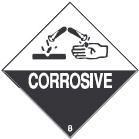Everyday Hazmat User’s Training Guide
Introduction (continued)
Hazardous Materials Placards
The U.S. Department of Transportation Hazardous Materials Regulations have established a family of placards, or graphic symbols, that uniquely identify certain chemicals and products. These placards are found on packages that have been prepared for shipment, and are often found on trucks transporting hazardous materials. These placards also can be used as signs to identify the contents of hazardous materials storage units. Most placards must measure at least 10.8 inches on each side, and conform to the color, lettering, and graphic symbols established by regulation.
Hazardous materials placards shall, with some exceptions, be used when you transport hazardous materials. Placards are required when any container exceeds 119 gallons, regardless of weight. Placards are not required on a vehicle or freight container loaded with less than 1,001 pounds of most hazardous materials, including some explosives, flammable gases, nonflammable gases, flammable liquids, combustible liquids, flammable solids, spontaneous combustibles, oxidizers, some forms of organic peroxides, poisons, and corrosives. Those hazardous products that always require placarding during shipment include some explosives, poisonous gases, dangerous when wet products, some forms of organic peroxides, poisons with inhalation hazards, and radioactive products. There are some specific requirements on shipments of combinations of hazardous materials; contact your hazmat coordinator for clarifications. If placards are required on your vehicles when transporting hazardous materials, the placard must be displayed on each end and each side of the vehicle. There are many different types and combinations of placards, so if you are in doubt, contact your hazmat coordinator.
 |
 |
 |
 |
 |
 |
 |
 |
 |
 |
 Toxic Compressed Gases |
 Corrosive Compressed Gases |
